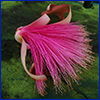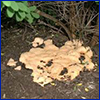The Neighborhood Gardener – August

Happy gardening!
Plant ID Service
 Do you have a burning plant identification question, but wonder who to ask for help? Well, wonder no more: for the first time in nearly three decades, the UF/IFAS Plant Identification and Information Service has a full-time extension botanist! Marc Frank joined the service on July 1, 2016 and has extensive experience in identifying a wide variety of plant materials. More
Do you have a burning plant identification question, but wonder who to ask for help? Well, wonder no more: for the first time in nearly three decades, the UF/IFAS Plant Identification and Information Service has a full-time extension botanist! Marc Frank joined the service on July 1, 2016 and has extensive experience in identifying a wide variety of plant materials. More
Turmeric
 Turmeric (Curcuma longa) is a beautiful and healthy addition to your Florida garden. Turmeric has been used in dishes for thousands of years and is a major component in curry. Researchers are also looking at the possible health benefits related to turmeric, including potentially anti-inflammatory properties. More
Turmeric (Curcuma longa) is a beautiful and healthy addition to your Florida garden. Turmeric has been used in dishes for thousands of years and is a major component in curry. Researchers are also looking at the possible health benefits related to turmeric, including potentially anti-inflammatory properties. More
Charlotte County FFL Training a Success
 Each year, Tom Becker with the UF/IFAS Charlotte County Extension Service conducts Florida-Friendly Landscaping™ (FFL) training for all the county's Master Gardener trainees. Florida-Friendly Landscaping™ is a key, overarching concept that guides not only horticultural decision-making, but also recommendations to the public. After a test to determine the 14 trainees' understanding of FFL concepts and practices, it was clear that the training was a success. More
Each year, Tom Becker with the UF/IFAS Charlotte County Extension Service conducts Florida-Friendly Landscaping™ (FFL) training for all the county's Master Gardener trainees. Florida-Friendly Landscaping™ is a key, overarching concept that guides not only horticultural decision-making, but also recommendations to the public. After a test to determine the 14 trainees' understanding of FFL concepts and practices, it was clear that the training was a success. More
Wendy's Wanderings
 As Master Gardener Volunteers and gardening enthusiasts, we are often faced with plant problems in the garden or landscape that need to be solved. If you are a Master Gardener working the horticulture hot line or at a plant clinic, people bring plant problems directly to you. Where do you even begin to start on the unsolved mysteries of the horticulture world? More
As Master Gardener Volunteers and gardening enthusiasts, we are often faced with plant problems in the garden or landscape that need to be solved. If you are a Master Gardener working the horticulture hot line or at a plant clinic, people bring plant problems directly to you. Where do you even begin to start on the unsolved mysteries of the horticulture world? More
Plant of the Month: Staghorn Fern
 Once an uncommon plant find, staghorn ferns (Platycerium spp.) are now quite popular and widely available. These plants are great for beginners or easily distracted gardeners. Staghorn ferns have beautiful and unusual foliage and are found throughout much of the tropical world. They thrive in South Florida and can be grown in North and Central Florida as long as they're protected from frost or freezes. Staghorn ferns are epiphytes, meaning they get moisture and nutrients from the air— they're found growing harmlessly on tree trunks, branches, or rocks. More
Once an uncommon plant find, staghorn ferns (Platycerium spp.) are now quite popular and widely available. These plants are great for beginners or easily distracted gardeners. Staghorn ferns have beautiful and unusual foliage and are found throughout much of the tropical world. They thrive in South Florida and can be grown in North and Central Florida as long as they're protected from frost or freezes. Staghorn ferns are epiphytes, meaning they get moisture and nutrients from the air— they're found growing harmlessly on tree trunks, branches, or rocks. More
August in Your Garden
 August is a great time to start planning your fall garden. While it's still a little too warm to start cool-season vegetables, North and Central Florida gardeners may be able to plant a second crop of warm-season vegetables like tomato and eggplant. All Florida gardeners can start preparing for cool-season planting. Have your soil tested so you can add the proper amendments before planting, and plan out what you want to grow and where you'll plant it.
August is a great time to start planning your fall garden. While it's still a little too warm to start cool-season vegetables, North and Central Florida gardeners may be able to plant a second crop of warm-season vegetables like tomato and eggplant. All Florida gardeners can start preparing for cool-season planting. Have your soil tested so you can add the proper amendments before planting, and plan out what you want to grow and where you'll plant it.
For more month-by-month gardening tips, check out the Florida Gardening Calendar. Three different editions of the calendar provide specific tips for each of Florida's gardening regions—North, Central, and South.
Water Gardens
 Adding a water garden is a great way to introduce new textures to your landscape; even a gentle fountain can add relaxing sounds to your backyard oasis. Just make sure that your water garden isn't providing mosquitoes with a breeding ground. Bacillus thuringiensis israelensis (Bti) is safe for plants and animals; added to any permanent water feature in the landscape, it will prevent mosquitoes from becoming a problem. More
Adding a water garden is a great way to introduce new textures to your landscape; even a gentle fountain can add relaxing sounds to your backyard oasis. Just make sure that your water garden isn't providing mosquitoes with a breeding ground. Bacillus thuringiensis israelensis (Bti) is safe for plants and animals; added to any permanent water feature in the landscape, it will prevent mosquitoes from becoming a problem. More
Slime Molds
 Slime molds can be a shocking sight in the garden, but they are relatively harmless and usually dissipate on their own. Slime mold is caused by the fruiting bodies of Myxomycetes, a type of fungi regularly present in soil. It's during these humid summer days that you may see slime mold develop. It may look like your lawn has been spray painted with black or grey paint. Or, in the case of "dog vomit" slime mold (Fuligo septica ), you may see what looks like yellow foam in your landscape. There are no fungicides to treat slime mold, but you can lightly mow, rake, or use a forceful stream of water to break it up and restore your landscape to its aesthetic glory.
Slime molds can be a shocking sight in the garden, but they are relatively harmless and usually dissipate on their own. Slime mold is caused by the fruiting bodies of Myxomycetes, a type of fungi regularly present in soil. It's during these humid summer days that you may see slime mold develop. It may look like your lawn has been spray painted with black or grey paint. Or, in the case of "dog vomit" slime mold (Fuligo septica ), you may see what looks like yellow foam in your landscape. There are no fungicides to treat slime mold, but you can lightly mow, rake, or use a forceful stream of water to break it up and restore your landscape to its aesthetic glory.
What's Going On?
If your Master Gardener program or Extension office is having an event, be sure to share it with us.

